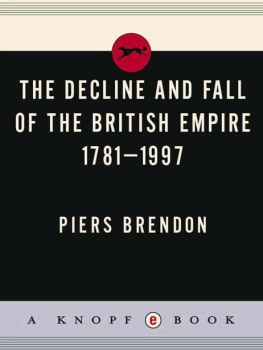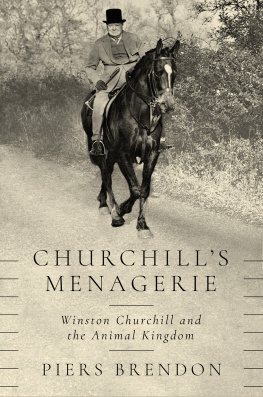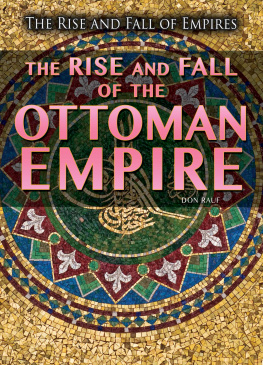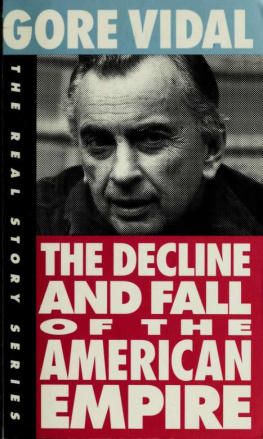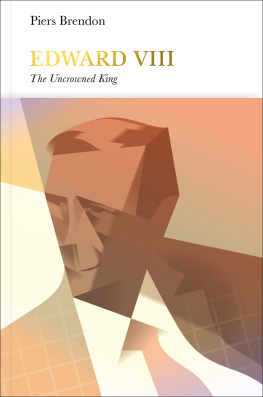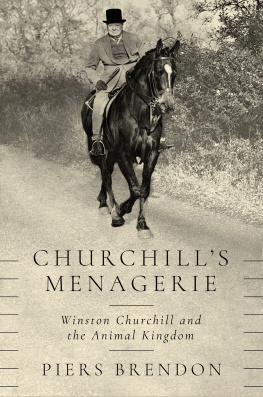Piers Brendon - Decline and Fall of the British Empire, 1781-1997
Here you can read online Piers Brendon - Decline and Fall of the British Empire, 1781-1997 full text of the book (entire story) in english for free. Download pdf and epub, get meaning, cover and reviews about this ebook. year: 2008, publisher: Alfred A. Knopf, genre: History. Description of the work, (preface) as well as reviews are available. Best literature library LitArk.com created for fans of good reading and offers a wide selection of genres:
Romance novel
Science fiction
Adventure
Detective
Science
History
Home and family
Prose
Art
Politics
Computer
Non-fiction
Religion
Business
Children
Humor
Choose a favorite category and find really read worthwhile books. Enjoy immersion in the world of imagination, feel the emotions of the characters or learn something new for yourself, make an fascinating discovery.
- Book:Decline and Fall of the British Empire, 1781-1997
- Author:
- Publisher:Alfred A. Knopf
- Genre:
- Year:2008
- Rating:4 / 5
- Favourites:Add to favourites
- Your mark:
- 80
- 1
- 2
- 3
- 4
- 5
Decline and Fall of the British Empire, 1781-1997: summary, description and annotation
We offer to read an annotation, description, summary or preface (depends on what the author of the book "Decline and Fall of the British Empire, 1781-1997" wrote himself). If you haven't found the necessary information about the book — write in the comments, we will try to find it.
Decline and Fall of the British Empire, 1781-1997 — read online for free the complete book (whole text) full work
Below is the text of the book, divided by pages. System saving the place of the last page read, allows you to conveniently read the book "Decline and Fall of the British Empire, 1781-1997" online for free, without having to search again every time where you left off. Put a bookmark, and you can go to the page where you finished reading at any time.
Font size:
Interval:
Bookmark:


CONTENTS

To
Vyvyen
With love and thanks

ILLUSTRATIONS

Section One
Missionary with Tahitian converts (Corbis); Wedgwood anti-slavery medallion (Wilberforce House, Hull City Museums and Art Galleries/Bridgeman Art Library); Imperial interior, 1890 (Getty); Lord and Lady Curzon hunt in Hyderabad, 1902 (AKG-London); Hyderabads army polo team (Corbis); Sir James Grigg enters Simla, 1938 (Corbis); Hong Kong Harbour seen from Victoria Park (John Hillelson Collection); The CPRs Iron Horse (Vancouver Public Library, Special Collections); Indian Railway engraving by Indian School (Private Collection/Bridgeman); Teatime in Ceylon (Corbis); Ceylon tea harvest (Corbis); King Thibaw and Queen Supayalat of Burma (Corbis); Christmas day in Burma, 1885 (Corbis); Scottish troops beside the Sphinx, 1882 (Corbis); Tourists on the Great Pyramid, 1938 (Corbis); Imperial stamps (Private Collection)
Section Two
Sikh officers and men, 1858 (National Army Museum, London/Bridgeman); Lucknow after the Mutiny (Corbis); British camp in Afghanistan (Corbis); Afghan riflemen on the Khyber Pass (Corbis); Irish peasants in the 1880s (Corbis); Dublins General Post Office after the Easter Rising (Corbis); The Rhodes Colossus (Getty); Isandhlwana after the battle, 1879 (National Army Museum/Bridgeman); Gold miners in De Kaap, South Africa (Corbis); Boers at Spion Kop, 1900 (Corbis); A meal during the siege of Ladysmith (Popperfoto); Anzac Cove, Gallipoli, 1915 (Corbis); Indian military hospital, Brighton Pavilion (Corbis); The Japanese march on Rangoon, 1942 (Corbis); Nigerian sergeant in Burma, 1944 (Imperial War Museum, London, neg. no. IND3098); Trade follows the flag, ephemera (Robert Opie Collection)
Section Three
The Imperial appeal, ephemera (Robert Opie Collection); Gandhis Salt March, 1930 (Corbis); Nehru and Jinnah, 1946 (Corbis); The last Viceroy and Vicereine of India (Corbis); The refugees of Partition, 1947 (Corbis); Jewish refugees arrive at Haifa, 1946 (Corbis); The exodus of Palestinian refugees to Gaza (Corbis); British troops confront Cypriots, Nicosia, 1955 (Corbis); The troopship Empire Ken at Port Said, November 1956 (Getty); Detaining Mau Mau suspects in Kenya, 1952 (Corbis); Jomo Kenyatta is hailed as Prime Minister, 1963 (Corbis); Queen Elizabeth II on her tour of Nigeria, 1956 (Corbis); Kwame Nkrumah leads Ghana to Independence, 1957 (Corbis); The Union Jack is lowered in Hong Kong, 1997 (Onasia)
Front endpaper
Imperial Federation map of the world showing the extent of the British Empire in 1886 Royal Geographical Society, London
Back endpaper
World map showing shipping routes and the extent of the British Empire in 1927 Royal Geographical Society, London

ACKNOWLEDGEMENTS

This book ranges across five continents and more than two centuries, so the debts I have incurred during the six years it took to write are correspondingly extensive.
I must first thank friends and colleagues at Churchill College, Cambridge, who have helped me in countless ways. I am especially grateful to Allen Packwood, Director of the Churchill Archives Centre, and to past and present members of his outstanding team, notably Natalie Adams, Louise King, Andrew Riley and Katharine Thomson. Dr. Dick Whittaker provided me with indispensable guidance on the Roman Empire. Hywel George gave me a unique insight into the workings of the post-war British Empire. Dr. Alan and Judy Findlay arranged an illuminating tour of the Foreign and Commonwealth Office, courtesy of their son Matthew. Lady Julia Boyd recalled experiencing the end of the British Empire in person: after the handover in Hong Kong on 30 June 1997, she witnessed the royal yacht Britannia, with the last Governor, the Prince of Wales and other dignitaries on board, sailing into the darkness on her final voyage.
Most of my work was done at the Cambridge University Library, an incomparable resource for the historian, and I owe thanks especially to Rachel Rowe, Godfrey Waller and Peter Meadows, the Bible Society Librarian. Elsewhere librarians and archivists went out of their way to lighten my task. I am under particular obligation to Dr. Gareth Griffith, Director of the British Empire and Commonwealth Museum, who put a room at my disposal in Bristol, where I was also able to draw on the expertise of Jo Duffy. Roderick Suddaby gave assistance at the Imperial War Museum. So did Kevin Greenbank at the Cambridge Centre for South Asian Studies. Further afield, Dr. Saroja Wettasinghe, Director of the National Archives of Sri Lanka, eased my path into her collections. Suzanne Mallon took immense trouble to introduce me to manuscript material at the Mitchell Library in Sydney.
In the course of my research I visited a number of ex-colonial clubsthe Tollygunge in Calcutta, the Bangalore Club, the Hong Kong Club and so onwhere I was most courteously received. I am particularly grateful to Allan Oakley, Secretary of the High Range Club at Munnar in Kerala, and to Stanley Gooneratne, Secretary of the Hill Club in Nuwara Eliya, who was kind enough to open his records for me.
I have benefited from the aid and counsel of many individuals, among them Dan Burt, Professor Martin Daunton, Dr. Richard Duncan-Jones, Bill Kirkman, Gamini Mendis, Professor James Muller, Manus Nunan, Anthony Pemberton, Harold Rosenbaum, and Dr. Calder Walton. Sir Christopher Hum generously shared his diplomatic memories of the Sino-British negotiations over Hong Kong. Sydney Bolt reminisced with characteristic wit about Britains war-time Raj in India as well as commenting on parts of my typescript. Michael Murphy performed the same office for my Irish sections, decorating the text with sprightly marginalia. Rex Bloomstein devoted time he could ill afford to perusing my chapter on Palestine. Richard Ingrams not only unearthed a fascinating vignette of colonial Cyprus penned by Paul Foot soon after he left the school where we all three served time, but he also sent me relevant books to review for The Oldie. So, with his unerring literary eye, did Jeremy Lewis. Other friends contributed in different ways: Professor Christopher Andrew, my late and much-lamented literary agent Andrew Best, Professor Vic and Pam Gatrell, Tim Jeal, Sharon Maurice, Professor Richard Overy and John Tyler. Professor James Mayall allowed me to pick his brains over long lunches.
I also enjoyed imperial lunches with Dr. Ronald Hyam, the leading British authority on the end of Empire, to whom I owe more than I can say. He supervised me when I was an undergraduate at Magdalene College, advised me subsequently and, despite seeing his own book through the press, scrutinised every word of mine. His criticisms, corrections and suggestions were of inestimable value. Needless to say, despite all this extraneous help, I alone bear the responsibility for any mistakes that remain.
Font size:
Interval:
Bookmark:
Similar books «Decline and Fall of the British Empire, 1781-1997»
Look at similar books to Decline and Fall of the British Empire, 1781-1997. We have selected literature similar in name and meaning in the hope of providing readers with more options to find new, interesting, not yet read works.
Discussion, reviews of the book Decline and Fall of the British Empire, 1781-1997 and just readers' own opinions. Leave your comments, write what you think about the work, its meaning or the main characters. Specify what exactly you liked and what you didn't like, and why you think so.

